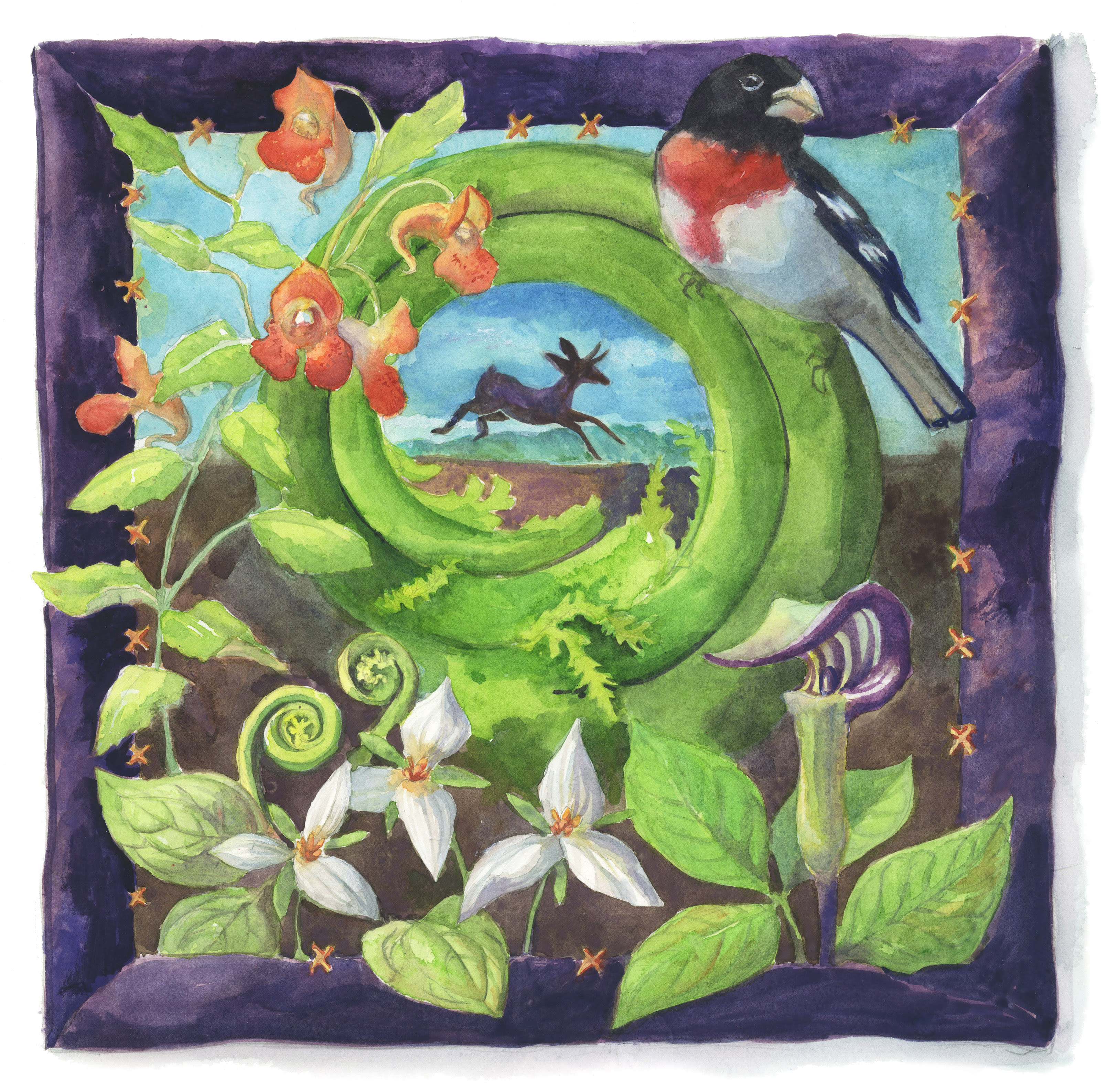
in the sparkling northwoods blue-green
today we gather
warmth of the longtime sun
to make a blanket for your bones
thick purple-brown twining grapevines
to knit a secret room of shade
a closed space without fear
to lie a long body down
to let go the burden of being upright
here in the crushed green
of fiddlehead and jewelweed
trilliums silently go crimson
binding our carmine blood
and this bit of wood
in the still pulpit, jack sits,
a silent preacher with nothing left to judge
only to witness you rest
welcoming hard scars that will turn to moss
your angular bones to be rounded with time
we bring the pull of purple magnetite
the charged ions/counterbalance
positive/negative canceled/reconciled
all accounts settled
we gather the echo in the steep shale walls
leaves written with pressure in time’s patient book
shut now
nothing more to be illuminated
we call on the grosbeak’s brilliant rose-petal stained breast
his love sung not said
his flashy plumes and sure song a fine cover
for his deep abiding shyness
we call upon the restless waves:
smooth the jagged past like beach glass
ready the sunset canvas
curving to calm in a still quiet bay
today we weave these ragged fragments together
a last quilt of protection
you pull to your chin
then you split down the middle
and turn to deer
as the jester’s gavel drops
on the hours of needing
to be more
Poet’s Note
A lorica (Latin for armor) is a prayer of protection. I first learned the term through St. Patrick’s Lorica, which also goes by St. Patrick’s Breastplate or The Deer’s Cry (Fáed Fíada in Irish, which can also be translated as “mist of concealment”). The legend goes that St. Patrick had a dream warning that Druids lay in wait for his traveling party. He woke and told his followers to chant this lorica, and as they passed by, the Druids saw only a doe and twenty fawns. You may already be familiar with St. Patrick’s Lorica as the invocation (based on James Clarence Mangan's “St. Patrick's Hymn before Tarah”) that Charles Wallace recites several times in Madeleine L’Engle’s A Swiftly Tilting Planet, one of my favorite books from childhood.
On the plane to see my deathly ill father at the Mayo Clinic in Minnesota, I thought I would write a lorica to steel myself. Things had always been strained between us, and my sister and I had recently learned that despite our belief that he had been a recovered alcoholic for over thirty years, he had secretly drunk at home and was dying of cirrhosis of the liver. It felt like I was flying straight into darkness.
I surprised myself by writing a sun-filled poem to protect him, instead. I called upon the plants and places of northwestern Pennsylvania, where I had grown up with him, to welcome him home. I had finally come to an understanding about the distance that had always been between us: it’s hard to welcome another in when you have so much to conceal. I think I’m more aligned with the Druids than St. Patrick these days, but even Patrick knew how much strength and comfort we can draw from the more-than-human world.
Artist’s Note
This illustration is a visual representation of Erin Robertson’s poem, “Bill’s Lorica.” I had never heard of loricas—prayers recited for protection from evil—until Erin told me about them, but the concept is very like the “charms” I draw when my loved ones are in crisis. For me, drawing and painting are like praying.
My work centers on nature and portraiture, and my guiding principle is to forge connections between people and nature. The animals and plants mentioned in the poem—(counter-clockwise from top left) jewel weed, fiddlehead fern, trillium, Jack-in-the-pulpit, and grosbeak—are in this illustration as witnesses and protectors to the passage of a life. The spiral of the fiddlehead fern is the central portal through which the spirit, represented by a stag, finds release and freedom along the strand. The images are framed by the border of a purple quilt, in reference to the lines "today we weave these ragged fragments together / a last quilt of protection."
This artistic collaboration between Erin and me grew from an online book club, where a group of women meet weekly during the pandemic to study books that connect natural science, spirituality, and life. Those weekly discussions threaded this path where words and watercolor met.